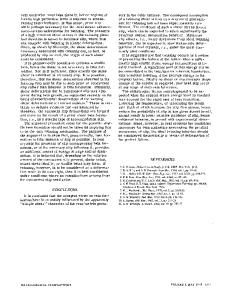Revealing the deformation twinning nucleation mechanism of BCC HEAs
- PDF / 692,299 Bytes
- 7 Pages / 612 x 792 pts (letter) Page_size
- 80 Downloads / 349 Views
Research Letter
Revealing the deformation twinning nucleation mechanism of BCC HEAs Zachary H. Aitken and Yong-Wei Zhang, Institute of High Performance Computing, A*STAR, 1 Fusionopolis Way, #16-16 Connexis, Singapore 138632, Singapore Address all correspondence to Zachary H. Aitken at [email protected] (Received 13 December 2018; accepted 17 January 2019)
Abstract Deformation twinning has been frequently observed in body-centered cubic (BCC) high entropy alloys (HEAs), however, the underlying mechanism remains elusive. We perform molecular dynamics simulations on a representative BCC HEA nanopillar under high-symmetry compression, describe atomic details of deformation twinning, and propose a mechanism of twin nucleation from the surface. We find that twinned regions are formed by partial dislocations and that chemical heterogeneity can reduce local fault energy and promote stacking faults and twins. These results help to understand the propensity for stacking fault formation and twinning in HEAs and may guide the design of novel HEAs through control of active twinning mechanisms.
Introduction Traditional metal alloying involves adding small amounts of secondary elements to a principal parent metal. Understanding of the resulting material properties is based on the resulting solid solution or presence of secondary phases. While there are many well-established, verified mechanisms for alloying effects in traditional metal alloys (e.g., dilute alloys), the physical mechanisms underlying material properties in alloys containing multiple principal elements are not yet understood. Such alloys, most commonly referred to in the literature as high entropy alloys (HEAs), display mechanical properties that can outperform traditional alloys. Refractory body-centered cubic (BCC) HEAs have shown thermal stability and high-temperature strength retention comparable with and even exceeding super alloys.[1–6] Transmission electron microscopy of deformed samples suggests that primary deformation mechanisms in these alloys are both dislocations and mechanical twinning.[7] Twinning has also been suggested to contribute to increased ductility in BCC refractory equi-atomic TiNbMoTaW HEA[8] and an equi-atomic TaNbHfZrTi HEA.[2] The face-centered cubic (FCC) equi-atomic CoCrFeMnNi HEA (also referred to as Cantor’s alloy) has displayed increasing strength and ductility with decreasing temperature.[9] Dominant deformation mechanisms observed in FCC HEAs have been dissociated dislocation pairs and mechanical twins.[10–18] While mechanical twinning directly contributes a small amount to the total strain, twinning is the primary source of high strain hardening in HEAs[9,18] due to the twin boundary acting as a barrier to dislocation motion as similarly observed in twinning-induced plasticity steels.[19–21] These experimental results show that twinning plays an important role in the deformation of both FCC and BCC
HEAs and the prevalence of twinning in HEAs is the source of some of their favorable mechanical properties. Twinning
Data Loading...











